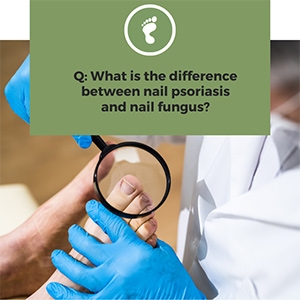It's the age-old question: is it psoriasis or is it fungi? For those of us who suffer from nail problems, it can be hard to tell the difference. Both conditions can cause similar symptoms, including yellowing, brittleness, and lifting of the nail. So how do you know which one you have? And more importantly, how do you treat it? Read on to find out.
Nail psoriasis and nail fungus are both common conditions that can cause similar symptoms. However, there are some key ways to tell them apart.
For one, nail psoriasis is typically characterized by a yellowing or whitening of the nails. Nail fungus, on the other hand, usually causes the nails to become yellow or brown and is often caused by trauma (especially from getting pedicures…sorry!) or wearing nail polish too long. In addition, nail psoriasis can often lead to pitting or ridging of the nails, while fungus generally causes the nails to thicken and become brittle.
So how do you treat these conditions? If you think you might have nail psoriasis, it's important to see a podiatrist. This is because nail psoriasis is a chronic condition that cannot be cured. However, there are a number of treatments that can help to control the symptoms and prevent further damage to the nails.
Nail fungus, on the other hand, is not chronic and is very treatable. We can get your toenails back to normal. There are several different options when treating nail fungus.
Treatments options
Lamisil:
Lamisil has long been considered the “gold standard” for treating fungus. It is an oral medication taken one week out of every month for a year. Lamisil can be harsh on the liver, therefore blood work needs to be performed in advance to make sure your liver is healthy enough for this medication.
You are not a candidate for this medication if you are already taking medication for high cholesterol (or any other medication that is metabolized by the liver)( or if you have poor circulation.
Laser Therapy:
Laser therapy is the most cutting-edge and effective way to treat nail fungus. Our laser is FDA cleared and there are no side effects! The laser promotes healthy nail growth by increasing the circulation to the area. One round of laser therapy consists of six treatments performed once a month over the course of six months. The treatments are painless and can be performed in approximately 15 minutes based on the number of toenails affected. There is no downtime after laser treatment.
If you have a progressed case of fungus, then it might be necessary to remove the nail before performing laser treatment. In cases like this, the nail is too thick and infected for treatment to be effective. We need to start with a clean slate in order to get the best results possible. In the event that you need to have your toenail removed, you can start laser treatment approximately 2-3 weeks after the procedure. If you want to know what that procedure looks like, check out this YouTube video.
Unfortunately, laser treatment is not covered by insurance at this time. Your insurance considers toenail fungus is considered cosmetic, much like Botox. There is no medical harm in leaving your nails unsightly. However, we fully understand that you don’t want to have unsightly nails. Good news! FSA, HSA and Care Credit will cover this treatment option. The cost of laser therapy can also be broken down into monthly payments if you need.
Laser treatment is not recommended for patients who are pregnant or have active cancer.
Laser treatment works best in conjunction with topicals to treat superficial fungus and prevent progression of the infection. We recommend using Mod Pod Repair. Containing a mix of essential oils and the thinning properties of urea, Repair is designed to eliminate fungus and hydrate & soften thick, brittle toenails. This easy to apply topical antifungal will help remove yellow and discolored build-up, leaving you with smoother and healthier nails.
So, are your nails looking a little funky? Before you start self-diagnosing, it’s important to know the difference between psoriasis and fungal infection. Both of these conditions can be treated, but the treatment is different for each one. If you think you might have one of these nail problems, call us at or schedule an appointment online with our team so we can help get your nails back to looking healthy again.

